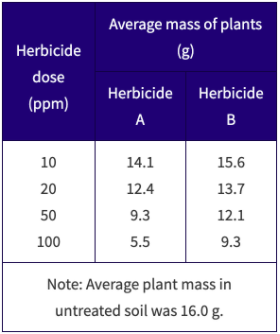Herbicides are used to control the growth of weeds. An herbicide that may be used safely with one crop species may damage another crop if the latter crop is planted in soil containing residual amounts of the herbicide from an earlier application. The following experiment was performed to study this effect:
A botanist filled 90 pots with Soil Type 1. No herbicide was added to the soil in 10 pots. The other pots were divided into groups of 10 and the soil in each group was treated with 10, 20, 50, or 100 ppm of either Herbicide A or B. All other factors were held constant. Ten seeds of a corn hybrid were planted in each pot. After 40 days, the plants were uprooted, oven-dried, and weighed. The results are shown in the following table:

Which of the following sets of plants served as the control in the experiment?
Correct
Incorrect
The correct answer is (A).
Getting to the Answer: Review the method for the Experiment to identify which set of plants served as the control. The control group is the group that does not receive the experimental treatment and is used as a baseline to compare with the treated groups. According to the Experiment, "No herbicide was added to the soil in 10 pots. The other pots were...treated with 10, 20, 50, or 100 pm of either Herbicide A or B." Thus, the plants grown in soil without herbicide served as the control in the Experiment.
(A) Correct: this matches the analysis above; the set of plants grown in untreated soil was the control group
(B) Incorrect: since this set of plants received 10 ppm of Herbicide A treatment, it was not the control but a treated group
(C) Incorrect: since this set of plants received 10 ppm of Herbicide B treatment, it was not the control but a treated group
